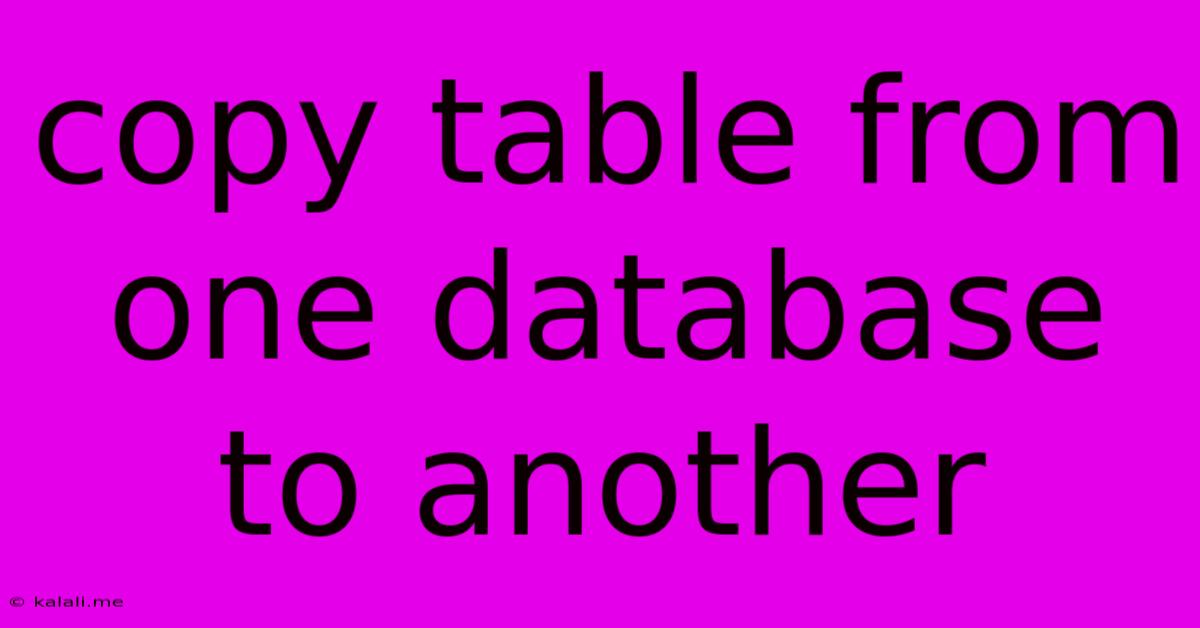Copy Table From One Database To Another
Kalali
Jun 07, 2025 · 3 min read

Table of Contents
Copying Tables from One Database to Another: A Comprehensive Guide
Copying a table from one database to another is a common task in database administration and data management. This comprehensive guide will walk you through various methods, highlighting their advantages and disadvantages, to help you choose the best approach for your specific needs. Whether you're migrating data, creating backups, or performing data analysis, understanding these techniques is crucial.
Understanding the Challenges
Before diving into the solutions, let's acknowledge the potential challenges:
- Database Systems: The source and destination databases might use different systems (e.g., MySQL to PostgreSQL, SQL Server to Oracle). This requires understanding the nuances of each system and employing appropriate data conversion techniques.
- Data Volume: Copying large tables can be time-consuming and resource-intensive. Efficient methods are essential to minimize downtime and optimize performance.
- Data Integrity: Maintaining data integrity throughout the process is paramount. Errors during the copy process can lead to data loss or inconsistency.
- Permissions and Access: Ensure you have the necessary permissions to access both the source and destination databases.
Methods for Copying Database Tables
Several methods exist for copying tables between databases, each with its own strengths and weaknesses:
1. Using INSERT INTO ... SELECT Statements (SQL):
This is a straightforward approach suitable for smaller tables and when both databases use the same SQL dialect.
- Advantages: Simple and readily understood.
- Disadvantages: Can be slow for large tables; requires careful consideration of data types and potential data conflicts.
INSERT INTO destination_database.destination_table (column1, column2, column3)
SELECT column1, column2, column3
FROM source_database.source_table;
2. Using Database-Specific Utilities:
Many database systems provide their own utilities for data import and export. Examples include mysqldump for MySQL, pg_dump for PostgreSQL, and SQL Server Management Studio's import/export wizards.
- Advantages: Often optimized for performance and handle large datasets efficiently.
- Disadvantages: May require specific knowledge of the chosen utility; the process might be less flexible than writing custom SQL.
3. Using ETL (Extract, Transform, Load) Tools:
ETL tools like Apache Kafka, Informatica PowerCenter, or Talend Open Studio are powerful solutions for complex data integration tasks. They provide features for data transformation, error handling, and scheduling.
- Advantages: Highly efficient for large datasets, robust error handling, and excellent for complex transformations.
- Disadvantages: Can be complex to set up and require specialized skills. Often commercial products with associated costs.
4. Using Programming Languages (Python, etc.):
Programming languages offer flexible approaches, allowing you to customize the data transfer process. Libraries like psycopg2 (for PostgreSQL) or mysql.connector (for MySQL) can simplify database interaction.
- Advantages: High level of customization, allows for complex data transformations and error handling.
- Disadvantages: Requires programming skills; development time may be longer compared to other methods.
Choosing the Right Method
The optimal method depends on several factors:
- Size of the table: For small tables,
INSERT INTO ... SELECTis often sufficient. For large tables, database utilities or ETL tools are recommended. - Database systems: If the databases are different, ETL tools or programming languages offer greater flexibility in handling data type conversions.
- Data transformation needs: If significant data transformations are required, ETL tools or programming languages are preferable.
- Available resources and expertise: Choose a method that matches your technical skills and available resources.
Best Practices
- Backup your data: Always back up your source and destination databases before commencing the copying process.
- Test your process: Test the copying process on a small subset of data before applying it to the entire table.
- Monitor performance: Monitor the process closely to identify and resolve any performance bottlenecks.
- Handle errors gracefully: Implement proper error handling mechanisms to ensure data integrity.
By carefully considering these methods and best practices, you can efficiently and reliably copy tables between databases, ensuring data integrity and minimizing downtime. Remember to choose the approach that best fits your specific needs and technical capabilities.
Latest Posts
Latest Posts
-
How Long Does Rokokos Retargeting Take
Jun 07, 2025
-
Are Bolted Connections Fixed Or Pinned
Jun 07, 2025
-
How To Take Out A Broken Screw Head
Jun 07, 2025
-
What Angle To Join 3 Right Isosceles Triangles
Jun 07, 2025
-
How To Make A Speaker Louder
Jun 07, 2025
Related Post
Thank you for visiting our website which covers about Copy Table From One Database To Another . We hope the information provided has been useful to you. Feel free to contact us if you have any questions or need further assistance. See you next time and don't miss to bookmark.